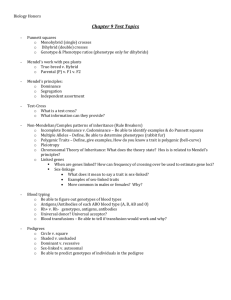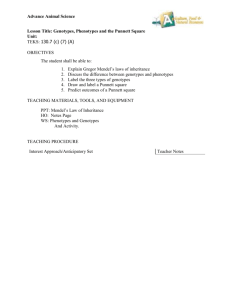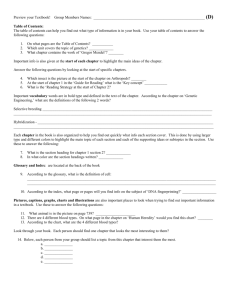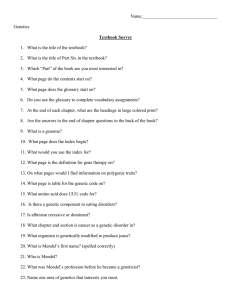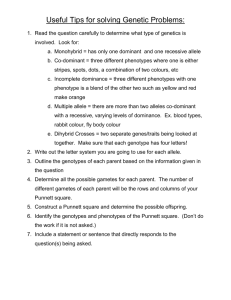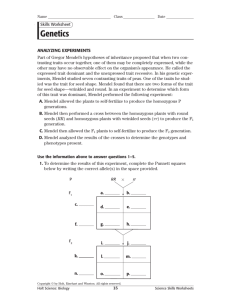Gregor Johann Mendel (1822 - 1884) © 2010-2013
advertisement
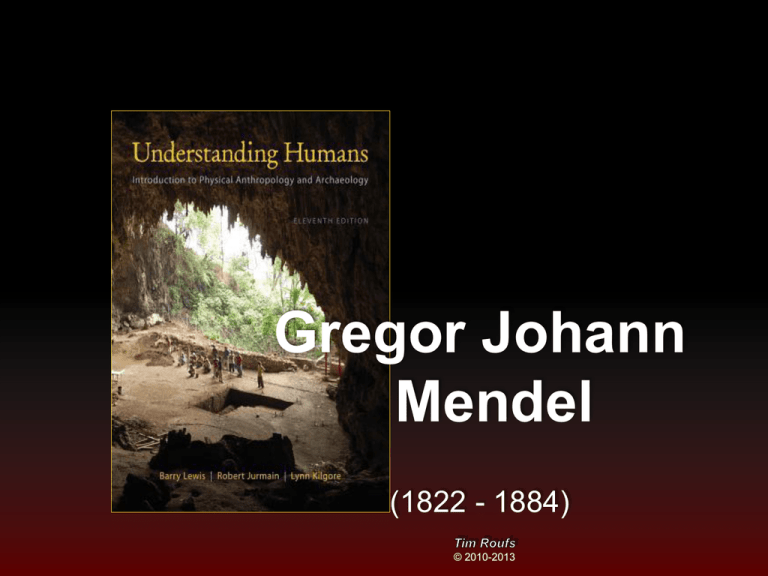
Gregor Johann Mendel (1822 - 1884) © 2010-2013 © 2010-2013 http://www.d.umn.edu/cla/faculty/troufs/anth1602/ Important People / Works Gregor Johann Mendel (1822 - 1884) Understanding Physical Anthropology and Archaeology, 11th ed., p. 48 Gregor Mendel Understanding Humans, 10th ed., p. 50 some basic terms . . . Glossary “inherited characteristics” genetically determined traits e.g., eye color 11th Ed. p. 56 Glossary “acquired characteristics” learned traits e.g., the ability to write Glossary blending inheritance an earlier theory stating that offspring receive a combination of all characteristics of each parent through the mixture of their “bloods” Glossary blending inheritance an outmoded theory superseded by Mendelian genetics Glossary particulate inheritance physical traits are inherited as “particles” • Mendel did not know what the particles were • today they’re recognized as particles like chromosomes and DNA chromosomes discrete structures composed of DNA and protein found only in the nuclei of cells The cell’s three dimensional nature Understanding Humans, 11th ed., p. 39 A model of a human chromosome Understanding Humans, 11th ed., p. 44 Glossary phenotype genotype Glossary phenotype genotype Glossary phenotype • the observable physical characteristics of an organism • the things you can see • the detectable expressions of genotypes “Some examples of phenotypic variation among Africans.” San (South African) Understanding Humans, 10th ed., p. 76 “Some examples of phenotypic variation among Africans.” San (South African) Understanding Humans, 10th ed., p. 76 Glossary phenotype genotype Glossary genotype • includes genetic items you can not see gametes are “reproductive cells (eggs and sperm in animals) developed from precursor cells in ovaries and testes” Punnett square representing possible genotypes and phenotypes Understanding Humans, 11th ed., p. 51 Punnett square representing possible genotypes and phenotypes Understanding Humans, 11th ed., p. 51 Punnett square representing possible genotypes and phenotypes Understanding Humans, 11th ed., p. 51 Punnett square representing possible genotypes and phenotypes Understanding Humans, 11th ed., p. 51 Understanding Humans, 11th ed., p. 50 Gregor Mendel The traits Mendel studied in peas Understanding Humans, 11th ed., p. 49 The traits Mendel studied in peas Understanding Humans, 11th ed., p. 49 www.blc.arizona.edu/courses/181gh/rick/genetics1/mendel.html AA aa Punnett square representing possible genotypes and phenotypes and their proportions in the F2 generation. Understanding Humans, 10th ed., p. 53 Conceptos básicos : Mendel: Experiment 1 Aa Aa Punnett square representing possible genotypes and phenotypes and their proportions in the F2 generation. Understanding Humans, 10th ed., p. 53 Conceptos básicos : Mendel: Experiment 1 3:1 ratio of Yellow : Green in F2 http://nitro.biosci.arizona.edu/courses/EEB195-2007/Lecture02/Lecture02.html Results of crosses when only one trait at a time is considered Understanding Humans, 11th ed., p. 49 AA + aa Aa + Aa Genotypes and phenotypes in the F1 generation. Conceptos básicos : Mendel: Experiment 1 AA aa AA aa Aa Aa Aa AA + 2 Aa + aa 25% + 50% + 25% AA Aa aa 75% AA or Aa 25% aa Punnett square representing possible genotypes and phenotypes and their proportions in the F2 generation. Understanding Humans, 11th ed., p. 51 75% 25% Punnett square representing possible genotypes and phenotypes and their proportions in the F2 generation. Think-Quest: Introduction to Genetics Glossary dominant describing a genetic trait governed by an allele (one of a group of genes) that can be expressed in the presence of another, different allele Genotypes and phenotypes in the F1 generation. Conceptos básicos : Mendel: Experiment 1 Glossary recessive describing a genetic trait that is not expressed in heterozygotes Aa Tt Glossary recessive for a recessive allele to be expressed, there must be two copies of the allele, i.e., the individual must be homozygous aa tt Crosses with Two traits http://nitro.biosci.arizona.edu/courses/EEB195-2007/Lecture02/Lecture02.html Glossary sex-linked trait traits carried by genes located on the X or Y sex chromosomes genetically normal females: XX genetically normal males: XY Glossary sex-linked trait • most X-linked characteristics are recessive in females • which means that unless they are present on both X chromosomes of a female, the trait is carried but not expressed Glossary sex-linked trait • males, with only one X chromosome, more commonly exhibit such traits phenotypically •e.g. hemophilia •e.g. red-green color blindness http://news.bbc.co.uk/2/hi/science/nature/8297467.stm http://news.bbc.co.uk/2/hi/science/nature/8297467.stm http://sciencenow.sciencemag.org/cgi/content/full/2009/1008/2 perth.uwlax.edu/faculty/howard/BIO101/DNA&translation/sld002.htm Diana “Kate” Middleton brie.medlabscience.med.ualberta.ca/de/genetics/70gen-hemophil.html sex-linked trait aka “Holandric Inheritance” • Y-linked traits, which are directly involved with determining maleness, are manifested only by males • known examples are rare but probably include the long hairs on the ear rims of some adult males in India, Ceylon, Israel and aboriginal Australia Important People / Works Hugo de Vries (1848 - 1935) in 1900 rediscovered Mendel’s work on plant hybrids Hugo de Vries 1848-1935 Canal houses in Amsterdam. Mimicry Minnesota Department of Natural Resources Mimicry Predaatio: saaliin ja saalistajan kilpajuoksu so where did those pink flowers Come from? -- Penn State Biology Department Incomplete dominance in snapdragon color http://courses.bio.psu.edu/fall2005/biol110/tutorials/tutorial5.htm “In Mendel's experiments, offspring always looked like one of their two parents due to the complete dominance of one allele over the other.” “This is not always the case because some genes display incomplete dominance and individuals with heterozygous alleles exhibit a phenotype intermediate between those with homozygous alleles.” -- Penn State Biology Department http://courses.bio.psu.edu/fall2005/biol110/tutorials/tutorial5.htm “In Mendel's experiments, offspring always looked like one of their two parents due to the complete dominance of one allele over the other.” “This is not always the case because some genes display incomplete dominance and individuals with heterozygous alleles exhibit a phenotype intermediate between those with homozygous alleles.” -- Penn State Biology Department http://courses.bio.psu.edu/fall2005/biol110/tutorials/tutorial5.htm “Since neither allele dominates over the other, the use of an uppercase and lowercase version of the same letter is inappropriate. In this example, the character (i.e., flower color) is indicated by a letter (C), and the alleles (encoding the trait; i.e., white, blue or red) are listed as uppercase subscripts (recall, they are both uppercase because neither is dominant to the other).” -- Penn State Biology Department http://courses.bio.psu.edu/fall2005/biol110/tutorials/tutorial5.htm Misconceptions of Darwin’s Work Some thought Darwin’s work was anti-religious Wrong Misconceptions of Darwin’s Work Some thought Darwin took the position that humans descended from an ape Wrong “In the distant future . . . light will be thrown on the origin of man and his history.” – Origin of Species, 1859 Important People / Works Thomas H. Huxley (1825 - 1895) [Evidence as to] Man’s Place in Nature 1863 Thomas Henry Huxley 1825 - 1895 Frontispiece from T. H. Huxley's Evidence as to Man's Place in Nature (London: Williams and Norgate, 1863) Important People / Works Charles Darwin (1809 - 1882) • Origin of Species 1859 • Descent of Man 1871 Charles Darwin 1871 Prehistoric Cultures Continue on to Set #06B Conceptual Changes Between the 18th and 20th Centuries
